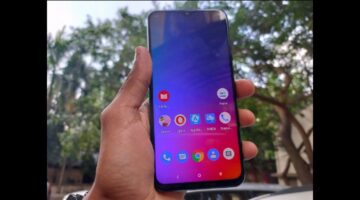Are you planning to buy a new smartphone within a specific budget? Lenovo has recently launched three new smartphones which cover a wide spectrum of the price. The Z6 Pro, K10 Note and the A6 Note. However, the K10 Note is placed in a mid-range budget segment. But how does the K10 Note perform in the real world? We have used the K10 Note for more than 10 days now and this is the review of the Lenovo K10 Note.
Look, Design and Hardware
The Lenovo K10 Note comes with a simple and minimalistic design. But do not be fooled as it looks quite elegant and has a great build quality. The body has been constructed from plastic which makes it even more lightweight. Even with a lot of usage, it never felt heavy to hold. The plastic back is prone to getting fingerprints which I personally feel is a tradeoff all smartphone makers so to use the back area for incorporating designs and patterns. You can wipe the back clean with a soft cloth and it should not be a problem. The rear is also the home for the triple camera setup and an LED flash. The fingerprint scanner is placed at the back as we have seen with most of the phones. On the right side, you have the power and the volume rocker keys while the left side houses the sim-card try. The bottom houses the USB Type-C port and the speaker grille and the still beloved 3.5mm headphone port. On the top, you can notice the small port for the secondary microphone. The overall design is simple and it looks quite stylish, especially if you consider its budget tag.
Now turn over the phone to the front, you will come to see the 6.3-inch Full-HD+ LCD display which gets a water drop-shaped notch on the top. It has an aspect ratio of 19.5:9. The bezels are quite thin except for the chin area at the bottom. Lenovo has skipped on Corning’s Gorilla Glass to use Panda Class for protection. The screen is quite bright and vibrant and is quite consistent at different viewing angles. Not only this, but the legibility of the screen in bright sunlight was also very good as I had no difficulty in reading whatever was on the screen.
Hardware specifications of the K10 Note include a Qualcomm Snapdragon 710 SoC which is paired with up to 6 GB of RAM and 128 GB of internal storage. The phone draws its power from a 4050mAh battery which also has support for 18W fast charging. The camera trio consists of a 16 MP primary camera, an 8MP secondary lens which gets 2X optical zoom and a 5 MP depth sensor. The front-facing camera is a 16 MP unit for selfies and video calling.
Now coming to the software of the smartphone, it runs Android 9.0 Pie out of the box. One noticeable factor is that you only have a very little level of customisation leaving with you a pure Android experience. Even with a high amount of multitasking, the phone did not face too many lags or stutters. You can enable gestures on this K10 Note via the 4D U-Touch in the settings menu. The K10 comes with a few additional applications installed but not all of them can be removed.
Performance and Camera Quality
Now moving towards the performance department of the Lenovo K10 Note, it appeared to run very smoothly for the entire duration of use. There was no lag observed while launching multiple applications or while switching between tabs. If you like playing games, you might encounter a bit of heating on continuous gameplay. However games like Asphalt 9: Legends on long session got the phone warm only slightly. The beautiful surprise is the battery life. The 4050mAh battery easily lasts a day of usage including a lot of multimedia content consumption and browsing social media applications, maps etc. The fast charger in the box means the phone could be fully charged in around two hours. Talking about multimedia, the sound output on the K10 Note is pretty impressive considering the fact it features Dolby Atmos and even with a single speaker, the sound output felt adequate. The fingerprint scanner of the K10 is fast and sometimes even faster than the facial recognition.
Now it is time we talk about the camera. The images from the K10 Note produced accurate colours and were evenly exposed with good amount of details. Focusing is not an issue when pointing at faraway objects but when going too close to the subject, it takes a moment to lock focus. In low lighting conditions, the images were decent. Turning the night mode on slightly enhances the images taken in dimly lit situations. The shots taken in the portrait mode worked well however, you cannot adjust adjust the level of blur like you can in some of the other smartphone portraits. The 16 MP selfie camera does a good job of taking selfies.
Final Verdict
For a price of Rs. 13,999/- the Lenovo K10 Note ticks all the boxes for a budget smartphone user. It comes with a bright display, smooth performance and a good battery life. The cameras could have been better but that is me, nitpicking on a budget device. If you are looking to not spend more than 15 thousand on a smartphone and a good software experience, then the Lenovo K10 Note is a very good contender waiting to be picked up.
